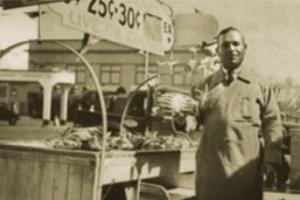dungeness crabs
Fisherman’s Wharf, which has been the home of San Francisco’s colorful fishing fleet for nearly a century and a quarter, is world famous for its wide variety of seafood. Much of this fame is due to the annual harvest of that most delectable of all crustaceans, the Dungeness crab of San Francisco.
 The opening of crab season in mid-November is a festive occasion. It is the day when the cauldrons along Fisherman’s Wharf are lighted, ready to receive the boxes piled high with Dungeness crab hoisted from the decks of the first boats that come chuffing back into port. It is a time for gourmet feasting that will last through many months to follow.
The opening of crab season in mid-November is a festive occasion. It is the day when the cauldrons along Fisherman’s Wharf are lighted, ready to receive the boxes piled high with Dungeness crab hoisted from the decks of the first boats that come chuffing back into port. It is a time for gourmet feasting that will last through many months to follow.
Traditionally, the opening of the crab season is preceded with a religious procession and a priestly blessing of the fleet. The boat decks are piled high with crab traps. The first day’s harvest is anxiously awaited as an indication of what the season will bring the crabbers as a reward for their hard work.
A century ago, crabs were in plentiful supply from the Straits of Carquinez on the inland reaches of San Francisco Bay to the sandy shorelines off Berkeley, Oakland and Alameda. Over the years, clams, the natural food of the crab, disappeared from the Bay. The best crab catches were then made just outside the Golden Gate. Today, the crabbers must drop their crab pots far out near the Farallon Islands in 18 to 35 fathoms of ocean water.
When the crabbers arrive at their fishing ground, their first chore is to set the crab traps, made of wire and about the size and shape of a tire. Inside each they place a bait jar and drop the weighted pot over the side. A small marker buoy painted with the owner’s colors and tethered to the trap floats to the surface. Each of the boats may drop up to 200 pots. By the time the last pots have been dropped, night has fallen. In the early dawn it is time to begin hauling in the traps. Only the largest crabs are selected. The smaller ones are returned to the water.
In the early days of the fishing fleet, the homes of the Italian fishermen boasted the areas finest cuisine. But, even before there were any sidewalks or restaurants at Fisherman’s Wharf, some of the fishermen set up cauldrons of boiling water for cooking the freshly caught crabs, dispensing them in paper cups as a crab cocktail to be enjoyed by visitors.
During the last quarter century, many restaurants have been established, with the traditional steaming crab cauldron in front of their place of business. Men in smocks attend the cauldrons, and still offer the visitors paper cups of fresh-cooked crab meat cocktails, or whole cooked crabs to take home.
Many of the dishes available at these restaurants are based on the seafood dishes which today’s fishermen’s parents, grandparents or great grandparents prepared in their native Italy, or in their San Francisco homes. It is dining such as to be found in no other place.






